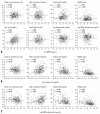Association of plasma retinol-binding protein 4, adiponectin, and high molecular weight adiponectin with insulin resistance in non-diabetic hypertensive patients
- PMID: 20376890
- PMCID: PMC2852793
- DOI: 10.3349/ymj.2010.51.3.375
Association of plasma retinol-binding protein 4, adiponectin, and high molecular weight adiponectin with insulin resistance in non-diabetic hypertensive patients
Abstract
Purpose: The aim of this study was to determine whether retinol-binding protein 4 (RBP4), adiponectin and high molecular weight (HMW) adiponectin are associated with insulin resistance (IR) and metabolic parameters in non-diabetic hypertensive patients. Also, we sought to compare the predictive values of these adipocytokines for IR in non-diabetic hypertensive patients.
Materials and methods: Analyses of RBP4, adiponectin, and HMW adiponectin were performed on 308 non-diabetic hypertensives (148 males, age 58 +/- 10 years, 189 non-metabolic syndrome and 119 metabolic syndrome). The homeostasis model assessment (HOMA) index for IR, lipid profiles, and anthropometric measurements were assessed.
Results: There was no significant difference in RBP4 levels according to the presence of metabolic syndrome, although adiponectin and HMW adiponectin were significantly lower in metabolic syndrome. Correlation analysis of log RBP4 with IR and metabolic indices revealed that there was no significant correlation of RBP4 with waist circumference (r = 0.056, p = 0.324), HDL cholesterol (r = 0.005, p = 0.934), ApoB/ApoAI ratio (r = 0.066, p = 0.270), and the HOMA index (r = 0.017, p = 0.756). However, adiponectin and HMW adiponectin showed significant correlations with the HOMA index (r = - 0.247, p < 0.001; r = - 0.296, p < 0.001) and metabolic parameters. With IR defined as HOMA index >or= 2.5, HMW adiponectin did not demonstrate a superior predictive value for IR compared to adiponectin (AUC = 0.680 vs. 0.648, p = 0.083). The predictive value of RBP4 for IR was minimal (AUC = 0.534).
Conclusion: RBP4 was not associated with IR or metabolic indices and the predictive value for IR was minimal in hypertensives. HMW adiponectin didn't have a superior predictive value for IR compared to adiponectin. Therefore, we can suggest that RBP4 and HMW adiponectin don't have more additive information than adiponectin in non-diabetic hypertensives.
Conflict of interest statement
The authors have no financial conflicts of interest.
Figures


Similar articles
-
Association of plasma retinol-binding protein-4, adiponectin, and high molecular weight adiponectin with metabolic adversities in patients with schizophrenia.Prog Neuropsychopharmacol Biol Psychiatry. 2011 Dec 1;35(8):1927-32. doi: 10.1016/j.pnpbp.2011.07.014. Epub 2011 Aug 5. Prog Neuropsychopharmacol Biol Psychiatry. 2011. PMID: 21840365
-
[Correlation of retinol binding protein 4 with metabolic indexes of glucose and lipid, bile cholesterol saturation index].Zhong Nan Da Xue Xue Bao Yi Xue Ban. 2015 Jun;40(6):657-65. doi: 10.11817/j.issn.1672-7347.2015.06.014. Zhong Nan Da Xue Xue Bao Yi Xue Ban. 2015. PMID: 26164516 Chinese.
-
Retinol-binding protein 4 is associated with components of the metabolic syndrome, but not with insulin resistance, in men with type 2 diabetes or coronary artery disease.Diabetologia. 2007 Sep;50(9):1930-1937. doi: 10.1007/s00125-007-0743-8. Epub 2007 Jul 18. Diabetologia. 2007. PMID: 17639305
-
Serum retinol-binding protein 4 correlates with obesity, insulin resistance, and dyslipidemia in HIV-infected subjects receiving highly active antiretroviral therapy.Metabolism. 2009 Nov;58(11):1523-9. doi: 10.1016/j.metabol.2009.04.021. Epub 2009 Jun 18. Metabolism. 2009. PMID: 19501863
-
Serum high-molecular-weight adiponectin as a marker for the evaluation and care of subjects with metabolic syndrome and related disorders.J Atheroscler Thromb. 2010 Dec 26;17(12):1201-11. doi: 10.5551/jat.6106. Epub 2010 Oct 8. J Atheroscler Thromb. 2010. PMID: 20948162 Review.
Cited by
-
Iron chelator alleviates tubulointerstitial fibrosis in diabetic nephropathy rats by inhibiting the expression of tenascinC and other correlation factors.Endocrine. 2013 Dec;44(3):666-74. doi: 10.1007/s12020-013-9907-0. Epub 2013 Mar 7. Endocrine. 2013. PMID: 23468095
-
Adiponectin protects rat myocardium against chronic intermittent hypoxia-induced injury via inhibition of endoplasmic reticulum stress.PLoS One. 2014 Apr 9;9(4):e94545. doi: 10.1371/journal.pone.0094545. eCollection 2014. PLoS One. 2014. PMID: 24718591 Free PMC article.
-
Serum retinol-binding protein 4 levels are elevated but do not contribute to insulin resistance in newly diagnosed Chinese hypertensive patients.Diabetol Metab Syndr. 2014 Jun 11;6:72. doi: 10.1186/1758-5996-6-72. eCollection 2014. Diabetol Metab Syndr. 2014. PMID: 24932224 Free PMC article.
-
Associations between retinol-binding protein 4 and cardiometabolic risk factors and subclinical atherosclerosis in recently postmenopausal women: cross-sectional analyses from the KEEPS study.Cardiovasc Diabetol. 2012 May 15;11:52. doi: 10.1186/1475-2840-11-52. Cardiovasc Diabetol. 2012. PMID: 22587616 Free PMC article. Clinical Trial.
-
Plasma adiponectin concentration and its association with metabolic syndrome in patients with heart failure.Yonsei Med J. 2012 Jan;53(1):91-8. doi: 10.3349/ymj.2012.53.1.91. Yonsei Med J. 2012. PMID: 22187237 Free PMC article.
References
-
- Kannel WB. Risk stratification in hypertension: new insights from the Framingham Study. Am J Hypertens. 2000;13:3S–10S. - PubMed
-
- Ansell BJ. Evidence for a combined approach to the management of hypertension and dyslipidemia. Am J Hypertens. 2005;18:1249–1257. - PubMed
-
- Wilson PW, Kannel WB, Silbershatz H, D'Agostino RB. Clustering of metabolic factors and coronary heart disease. Arch Intern Med. 1999;159:1104–1109. - PubMed
-
- Thomas F, Rudnichi A, Bacri AM, Bean K, Guize L, Benetos A. Cardiovascular mortality in hypertensive men according to presence of associated risk factors. Hypertension. 2001;37:1256–1261. - PubMed
-
- Adamczak M, Wiecek A, Funahashi T, Chudek J, Kokot F, Matsuzawa Y. Decreased plasma adiponectin concentration in patients with essential hypertension. Am J Hypertens. 2003;16:72–75. - PubMed
Publication types
MeSH terms
Substances
LinkOut - more resources
Full Text Sources
Medical
Miscellaneous

